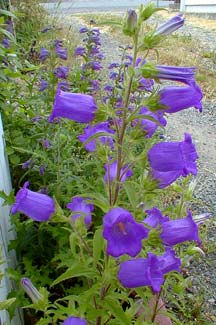
'Champion Blue'
Canterbury Bells
"I think the Canterbury bells are playing little tunes."
-Madonna of the Evening Flowers,
by Amy Lowell
by Amy Lowell
Canterbury Bells have deep "cup" flowers at least twice the size of the regular Peachbell Campanula varieties. While the Peachbells are perennials, the Canterbury Bells are biennials, & will die out of the garden in one or two years unless they self-seed, as they frequently do. Their first year they produce semi-evergreen basal leaves without stems, & their second year they flower.
Presumedly Canterbury Bells were so-named in the 12th Century because the blossoms resembled the bells that were hung upon the necks of horses who took pilgrims to the shrine of Thomas a'Beckett, archbiship of Canterbury.
But in & about the Elizabethan Era, they were better known as Coventry Bells, for they had naturalized & grew wild around Kent & Coventry such a very long time ago that their origins were practically forgotten & debated, though believed to have been introduced from the Pyrenees.
The Reverand William Hanbury in 1770 reported that the roots were popularly eaten, being "admired for their pleasant taste, frequently boiled."
We planted two varieties of Canturbery Bells, an improved pink (C. medium Rose) & an improved blue that to me seems quite purple, 'Champion Blue' introduced in 1998. The photo above was snapped in June. In the background a similarly-colored Midnight Blue Penstemon can be seen.
Basal leafage plus leafy flower stems raise to as high as three feet but usually about two feet. They begin blooming by May, sometimes earlier, but are floweriest in June & July. With deadheading it is possible to keep them blooming all the way through October. I have had a few of these return a third year for a second year of blooms, but this must be regarded as an unexpected bonus.
Canterbury Bells prefer full sun but will also do well with a moderate amount of shade. They're somewhat drought tolerant but not as much so as the penstemons. It will bloom in High Summer when some spring-bloomers or heat-sensitive things interupt their flowering.
Stems are usually sturdy enough to not require staking, but in a windy area may turn out to be floppy & require bracing. They attract hummingbirds but from my observation the hummingbirds spend considerably more time around the penstemons, which seem to have more nectar to reward each hummer's interest. Cut flowers last quite a while in bouquets.
C. takesimana,
Korean Bellflower